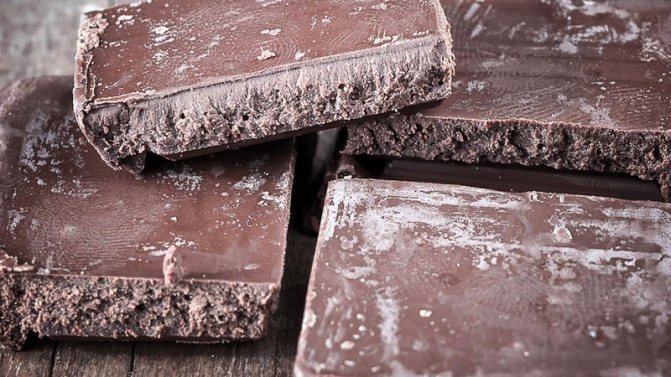What does it depend on?
First of all, the shelf life of sweets depends on the composition and method of production .
The wide variety of types of these sweets determines the different shelf life of the products.
Typically, the shelf life of candy is determined by the expiration date of the most perishable ingredient in the product. For example, fondant or icing spoils much faster than dark chocolate or fruit caramel filling.
Packaging also matters. Nowadays you rarely see sweets that are sold without boxes or candy wrappers, but in the USSR such sweets were quite common.
The shelf life of such sweets is much shorter than those wrapped in candy wrappers or packed in cardboard boxes.
What determines the shelf life of chocolate products?
All food products are provided with information about the expiration date of the product, including chocolate sweets. It is impossible to store them indefinitely, and safe use depends on many factors:
- fat and cocoa powder content;
- the presence of filling or filler in the form of nuts, dried berries and fruits, waffle or biscuit layer, rice balls;
- manufacturing method - factory or home;
- presence or absence of packaging;
- storage conditions: temperature, humidity, light.
Next, we will analyze all these factors in more detail.
What does it contain?
The popularity of candies and different pricing policies have led to the fact that many components can be used .
The main ingredient of sweets is sugar, because it is what gives them a sweet taste, which is why these products are loved. The percentage of sugar in candy usually reaches 65–75%. Also used in the production of sweets:
- chocolate;
- milk and cream;
- starch;
- molasses and syrup;
- fruits;
- dried fruits, candied fruits;
- condensed milk;
- nuts;
- gelatin;
- cocoa;
- halva;
- marshmallows;
- oil;
- flour;
- egg white;
- soy protein and fats;
- alcohol;
- preservatives, flavorings, thickeners and many other ingredients.
Storing chocolates at home
How to store sweets at home if the apartment is hot? Place them in the refrigerator or freezer.
In a refrigerator
If it’s hot at home and optimal conditions for storing chocolate cannot be created , it is sent to the refrigerator. At low temperatures, candy is stored for a long time without losing its original quality.
By wrapping the bars in several layers of paper, you will limit the access of cold air to them and create the optimal temperature for storing chocolate - about +16°C.
Important! When placing chocolate in the refrigerator, make sure it is well protected from moisture. To do this, wrap the tiles in foil.
The optimal place for chocolate products in the refrigerator is the bottom shelf or the shelf on the door.
In the freezer
Is it possible to store chocolates in the cold? Yes, you can if there is such a need. But be prepared for the fact that after defrosting, a white coating will appear on the chocolate surface . These are sucrose crystals released from chocolate.
Chocolate will lie in the cold without loss of taste for more than one year . But it is better to freeze and defrost it no more than once. Otherwise, both the appearance of the product and its taste will suffer.
What is the expiration date?
How long can candy last? Since the shelf life of sweets is set by manufacturers , it is quite difficult to indicate the exact limits for each type of sweets.
Modern production technologies and new components can significantly increase shelf life.
If we rely on Soviet GOSTs, we can establish approximate expiration dates for various types of sweets:
- for chocolates - from 2 to 4 months (for white chocolate - 1 month);
- caramels with fruit filling - up to 6 months;
- iris - from 2 to 6 months;
- candies without filling - 6 months;
- marmalade sweets - 2–3 months;
- roasted sweets - 2–3 months;
- sweets with fudge - from 25 to 45 days;
- sweets “Bird's milk” - 15 days;
- for marzipan sweets - from 10 to 45 days;
- cream sweets - up to 15 days;
- sweets based on creamy fudge - up to 3 days.
Soviet GOST standards have long been abolished, so modern manufacturers do not hesitate to add new components that significantly increase shelf life . However, the USSR standards are still suitable as a rough guide.
If all modern candies were made exclusively from natural ingredients, then their expiration dates would be exactly the same.
Deadlines
SANPIN says that the time during which pathogenic bacteria do not form on the surface of desserts ranges from 30 days to a year.
These standards apply to tiles of any origin: be it Russian or Swiss.
What determines the guaranteed shelf life? The value of this indicator is determined by a number of factors:
- amount of fat and cocoa powder;
- presence of flavoring additives;
- production conditions;
- storage conditions (temperature from +2 to +32, humidity from 30% to 93%).
Let's remember! A product with a wrapper is stored longer than without it. So, homemade delicacies have a freshness retention period of no more than 30 days.
Let's consider how long the most popular bars and bars should take before consumption:
- Twix, Snickers, Bounty, mars - 7 months, Nesquik - 6-9;
- Milka - 1 year (according to GOST, this type of confectionery product can be stored for no more than six months, probably the time is increased due to the preservatives in the composition);
- Alpen gold, Kinder chocolate eggs - 9-12 months (depending on the composition);
- classic “Alenka” tiles – six months;
- Babaevsky Firm, Babaevsky Elite, Inspiration classic, Spartak, Gold - 1 year;
- Karl phaser, callebaut - one and a half years;
- Karl, ritter sport, Russia generous soul, Nestle, Dove - six months to a year;
- Belgian callebaut - one and a half years;
- Instant powder for making hot chocolate - 2 years;
Products with nuts or with the addition of cookies should be stored less than classic ones. By using preservatives, manufacturers significantly extend this period of time. For example, Ritter sport with marzipan can remain good for a whole year.
After opening the package, it is best to consume the dessert within 24-48 hours. Do not store it completely open: it has the ability to absorb odors.
Lactic
Milk bars can be stored for 10 months if they do not have any flavoring additives (nuts, dried fruits, raisins, cheese, etc.). Otherwise, the time of safe use is reduced to six months.
White
This delicacy can be consumed without harm to health for 30 days from the date of manufacture. This is due to the presence of dairy derivatives in the composition.
Bitter
Bitter bars have the longest shelf life among their competitors, due to their high cocoa content and lack of additives.
With additives
A delicacy with dry additives retains its freshness for 180 days, but with a filling such as fudge, it is half as much - 90.
Candies
Their shelf life depends on the raw materials from which they are made and the presence of filling:
- The record holder among them is dark chocolate candies - 1-2 years;
- dark chocolate product - 1 year;
- from dairy - from six months to a year;
- glazed - 120 days;
- assorted assortments in a box and white chocolate candies - 60 and 30 days, respectively;
- with praline filling - 2 months.
Let's look at the most popular brands:
- Alpen gold, Korkunov, Mars - 9 months;
- French kiss - 90 days;
- Candies “Teddy bear” from the “Red October” factory, chocolate-covered strawberries, Martian - 6-7 months;
- Lind - 1 year;
- Mercy - up to 12 months, subject to the necessary conditions;
- The shelf life of natural truffle is 14 days.
In order to find out the production date and storage conditions of candies sold by weight, you must request a quality certificate from the seller (do not forget to check the batch number).
The shelf life of handmade sweets is much shorter due to the absence of factory packaging and preservatives. For example, a delicacy with the addition of chiboust cream is stored for no more than 2 days, with ganache cream - no more than 7 days, with the addition of liqueur - six months.
Chocolate based products
The shelf life of such products depends entirely on the type of raw materials used and the presence of various additives. Let's look at some of them:
- marshmallows in chocolate - up to 3 months. (for example, marshmallows from the famous Charmel brand retain their beneficial properties for only 60 days due to the complete absence of preservatives);
- the mousse is stored for only 24 hours due to the presence of perishable ingredients in it: milk, butter, etc.;
- pasta - 1 year;
- Shelf life of glazed cheese curds is maximum 15 days. How to treat cottage cheese products.
What do popular manufacturers say?
The shelf life of their products declared by manufacturers now rarely fits into the above framework. If the expiration date is higher, this indicates the presence of additional preservatives and substitutes .
For example, glazed chocolates “Marsianka” have a shelf life of 6 to 7 months , and similar products from 9 months.
Rot Front bars have a stated shelf life of 12 months , and the same products from the Permskaya confectionery factory have a shelf life of 6 months.
So even the sonority and popularity of the brand does not guarantee that additional preservatives or cocoa butter substitutes will not be found in the candy.
This does not necessarily mean that such sweets taste worse or can be harmful, but they still lack naturalness.
Therefore, if it is possible to study the composition of sweets, then it is better to do this and choose sweets with the least amount of substitutes and flavors.
How to store it correctly?
The optimal storage temperature for sweets is from +15 to +22°C, so there is no point in storing sweets in the refrigerator, and this significantly spoils their taste.
Therefore, store sweets at room temperature, avoiding direct sunlight, sources of high temperatures and strong odors. Air humidity should not exceed 75%.
Subject to storage conditions, the candies will not cause harm and will remain quite suitable much longer than the stated expiration dates.
For example, candy that has a shelf life of 6 months is still edible even 5 years after it was made. At the same time, with such types of sweets as fudge or creamy candies, it is better not to take risks and consume within the expiration date.
Factors affecting shelf life
The following points can be highlighted here:
- Production. Chocolate and candies are made in factories and at home. In the first case, the shelf life varies from 1 month to a year, depending on the consumer properties of the product and production technology. Homemade chocolate products are not recommended to be stored for more than 30 days;
- Package. Candies and chocolate sold by weight have a shorter shelf life than similar products that have original packaging.
The storage conditions prescribed by GOST also have a direct impact on the suitability of the product for consumption. Here are the conditions:
- transportation is carried out only by vehicles intended for transporting food products and having a sanitary passport;
- conditions of transportation and storage must comply with the requirements of the manufacturer;
- storage temperature from +5 to +20 degrees, air humidity no more than 70%;
- exposure to direct sunlight is unacceptable;
- Shared storage with products that have a specific odor is prohibited.
Important! Failure to comply with these requirements significantly reduces the shelf life of chocolate or makes it unfit for consumption.
How can you tell if candy is spoiled?
It is quite difficult to get poisoned by candy, since most types of products do not contain perishable ingredients.
First, the presentation is lost and the nutritional quality is reduced, and only then can the candy cause harm to health.
identify spoiled candies by the following signs:
- The shape of the candies has been disrupted - “old” candies usually lose moisture and “shrink” in size.
- A white or other coating has appeared.
- The taste of candy changes.
- Mold or even worms appear on the products.
If the above symptoms are found in sweets, it is better to stop consuming them.
They probably won’t cause serious harm to health, but they certainly won’t bring pleasure either.
What are the dangers of consuming a stale product?
Is it possible to eat candy that has an expiration date? Oddly enough, the main natural preservative that prevents spoilage of sweets is sugar, which is the main component of sweets.
Therefore, as long as you follow proper storage rules, candies with an expiring date are still quite safe. Typically, manufacturers indicate expiration dates with a large margin, so the approaching expiration date does not mean that the candies will definitely go bad.
If the appearance of sweets fully corresponds to the idea of quality products, then eating sweets with an expiring or even expired shelf life is quite safe .
You will find recommendations for storing stewed meat on our website.
Signs of expired chocolate
How can you tell if candy is spoiled? According to external and taste characteristics.
External
The following external signs indicate that the shelf life has expired or storage conditions have been violated::
- White sugar coating, indicating changes in temperature and humidity in the storage area.
- A white coating of fatty origin, indicating temperature changes or exposure to sunlight on the product.
- Presence of mold on the surface or inside the product.
- The presence of larvae and traces of vital activity of the chocolate moth. Moth caterpillars get into chocolate and candies during the production process or when ingredients are improperly stored. Insects make characteristic passages in the tiles, leaving small grains of feces and larvae in them.

Flavoring
Whether a product is safe is determined by its taste. If candies with chocolate glaze have a sour or astringent taste, it means that the production technology was violated, and it is better not to consume such a product.
The presence of a stale smell or rancid taste indicates that the product was not stored correctly. It is better to refuse such a delicacy.
Is it possible to eat an expired product?
Sugar and fat deposits only affect the appearance of the product . At the same time, the product retains its taste properties, nutritional and biological value and is quite suitable for consumption.
Need to know! Natural dark chocolate without additives is consumed for about six months after the expiration date, provided that it does not have a rancid taste.
You should definitely not eat candy that is affected by chocolate moths or covered with mold. Such a product can only be thrown into the trash.
Expired chocolate, but retaining acceptable appearance and taste, is subjected to heat treatment and used for making desserts, cakes, hot chocolate or chocolate glaze.










